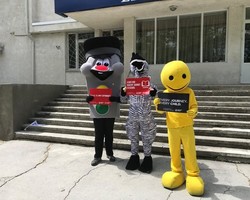Are you a leader for road safety? The Region marks United Nations Global Road Safety Week

WHO
“Leadership” was the theme for the 5th United Nations Global Road Safety Week on 6–12 May 2019. Through the WHO country offices, activities and events on road safety were organized across 14 countries in the WHO European Region in conjunction with government agencies (police, health, transport, etc.), nongovernmental organizations, academic institutions, media outlets, road safety activists and civil societies.
“Anyone can be a road safety leader. Anyone who acts and advocates for road safety, anyone who promotes their safety and that of others is a road safety leader,” says Jonathon Passmore, Programme Manager of Violence and Injury Prevention at WHO/Europe.
Over 230 people killed each day in the Region
According to the recent Lancet article “Progress in reducing road-traffic injuries in the WHO European Region”, over 230 people are killed each day due to road traffic injury. However, the article also reveals that the European Region and the Western Pacific Region are the only WHO regions to show reductions in the number of road traffic injuries since the global community adopted Sustainable Development Goal 3.6 to halve the number of road traffic deaths and injuries by 2020.
Strong leadership is needed to achieve this visionary and ambitious Goal. Global Road Safety Week provides an opportunity to galvanize intersectoral actions that are urgently required to improve road safety.
Engaging the leaders of tomorrow
With road traffic injuries the leading cause of death for children and young adults (those aged 5–29 years), many events placed an emphasis on youth engagement.
In Serbia, more than 120 children performed short plays, songs and recitals on the topic of safe participation in traffic. The events ended with the unanimous declaration of the “Road traffic oath for children”, which calls for child safety and the use of child seats and restraints.
In the Republic of Moldova, over 60 children marched across the streets of Chisinau to raise awareness of road safety. Children carried signs and banners with personalized messages such as “This is my street”, “A safe and healthy journey to school” and “Every journey, every child” to reinforce children’s right to a safe journey to and from school.
In Kyrgyzstan, a mobile car camp was created to teach children about traffic rules through games and activities. This camp was established with the support of traffic police, parliamentarians, government representatives, members of civil society, health-care professionals and local celebrities.
Engaging the community
Community engagement is paramount to raising awareness. In Uzbekistan, volunteers organized areas where people could speak up and take pictures for social media publications, and held a quiz on road safety rules for adults and children.
Other countries focused on educating the public on first aid for road traffic victims. In Bulgaria, volunteers demonstrated and explained basic rules for first aid following a road crash. In Tajikistan, media representatives participated in raising awareness of traffic regulations and other road safety campaigns on television.
In Romania, social media postings on road safety reached over 3000 people, strengthening the public health message that road traffic injuries are preventable.
In the Republika Srpska, Bosnia and Herzegovina, a series of activities took place throughout the week. Each day focused on a specific group, including vulnerable road users such as pedestrians and cyclists.
Engaging intersectoral counterparts
Road safety is a shared responsibility that spans all government ministries and agencies. During Global Road Safety Week, several countries held intersectoral policy dialogues and discussions on improving legislation and enforcement, road infrastructure, vehicle safety standards and road user behaviours. They took stock of what has been achieved to date and where further action is required.
Hungary conducted its first intersectoral roundtable discussion to monitor progress and prioritize actions for road safety in the country. Representatives of the police force, emergency services, the Institute for Transport Science, the National Public Health Centre, the Hungarian Scientific Association for Transportation, the Ministry of Innovation and Technology, and 6 departments of the Ministry of Human Capacities came together to develop a cross-sectoral roadmap to enhance road safety.
In Georgia, representatives of all key state institutions, civil society and international organizations sat down to discuss road safety management with a strong focus on post-crash care.
In Turkmenistan, participants discussed the implementation of the 5 components of the Decade of Action for Road Safety (2011–2020) and presented national data on road safety.
In Armenia and Montenegro, high-level meetings were held with key stakeholders and other United Nations agencies to discuss national and local activities on road safety.
In Ukraine, a policy dialogue focused on the development and approval of a methodology for physical and mental clearance for obtaining a driver’s license.
WHO engagement to improve road safety
Since 2004, WHO has supported Member States in developing capacity for injury prevention, raising awareness of the issues and providing technical support for strengthening systems of trauma care for road traffic victims.
Global Road Safety Week is a worldwide event that takes place every 2 years under the auspices of a United Nations General Assembly resolution. The first Global Road Safety Week took place in May 2007.



